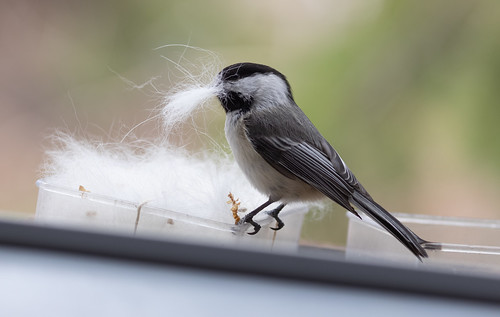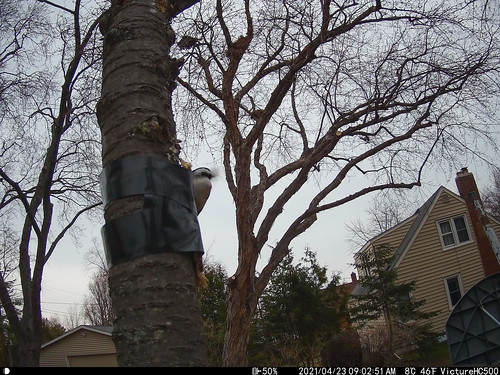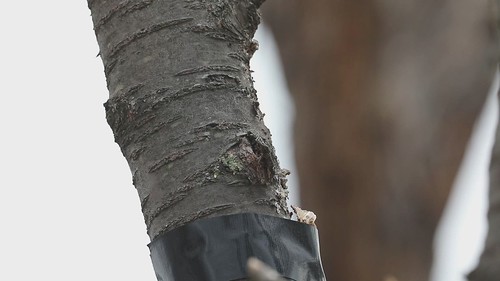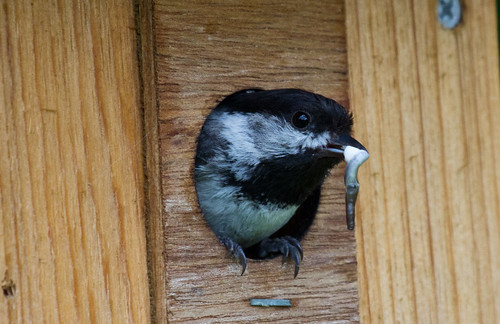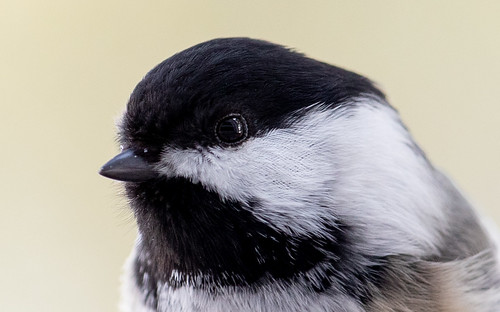On Friday, April 23, the chickadees building a nest in my dead cherry tree reached Stage 3 in this year’s nesting project. Stage 1 involved selecting the nest site—I wasn’t even aware of them at that point. Stage 2 was excavating the cavity. I don’t know how long they’d been at it when I discovered them on April 10. When I first saw them, they were mainly working on the entryway, and as they made the cavity deeper, they couldn’t yet turn around inside the hole—they had to back out. For several days, they were putting in nice bouts of time working but spending most of their time away. They may have been working on backups too—when they aren’t at the nest tree or at my window feeder, I don’t know where they are or what they’re doing.
By last weekend, I knew they were serious about this cavity—almost every time I looked out the window I could see them excavating. I don’t know how deep their cavity goes, but it must be pretty far down based on all the bits of wood they’ve carried out.
Last weekend, my neighbors Eden and Henry brought me a big wad of fur from their dog Ranger, and on Friday, April 23, I saw one chickadee collect a big clump of it at my window feeder and carry it to the nest, evidence that they were moving on to Stage 3, nest building.
My trail cam picked up the chickadee's arrival at the cavity with that very wad of fur.
I also got a 6-second video of a chickadee bringing some other kind of fluff—probably from some catkins—into the cavity.
When I worked at the Cornell Lab of Ornithology, I once saw a chickadee collecting small clumps of rabbit fur on the ground next to the trail. I have no idea where that fur came from, or how the chickadee discovered it, but it was really exciting to see, though the bird flew out of sight so I couldn’t track where its nest was.
According to Cornell’s Birds of the World, it is the female who builds the nest, which takes an average of 4-5 days to construct, with extremes of 2 days to 2 weeks. Once the nest is completed, the birds enter Stage 4, egg production. I should start seeing the female begging for food as this begins, but I won’t see much different activity at the nest, because during egg-laying, females may continue to bring some nesting materials in, but otherwise simply lay the egg early in the morning and leave.
Chickadee nests may have anywhere from 4 to 10 eggs. I took photos of chickadee nests inside Cornell nest boxes when I went out with one of the researchers—one nest had 6 eggs and one 9. The female lays one egg a day, occasionally missing a day, so Stage 4 lasts about a week or 10 days.
When my female lays her next-to-last egg, the birds will immediately enter Stage 5, incubation. I won’t be able to see inside the nest of course, but I'll know when that starts because the male will sometimes bring her food while she spends most of her time in the nest. Incubation lasts 12-13 days.
The eggs of a chickadee clutch all hatch within about 12–30 hours, bringing the nesting birds to Stage 6, taking care of the nestlings. The male will provide almost all the food for the female and babies at first, as she mostly stays in the nest brooding them. She starts pitching in as they can regulate their own body temperature. By Day 8, she’s bringing about 30 percent of the food, and it’s pretty much 50/50 by Day 13. I won't see the babies, but will be able to see the adults entering the nest with food and leaving it with fecal sacs. I've photographed that at other chickadee nests.
As the chicks get older, they sometimes peek out the cavity entrance.
If the chicks aren’t disturbed, they remain in the nest for 16 days, giving them their best chance of survival, but they can survive if frightened into early fledging as long as they’re at least 12 days old.
Stage 7, taking care of fledglings, is exhausting—the parents have to keep track of as many of them as possible, with the more insistent ones never giving them a moment’s rest. They usually stay together as a family for 3–4 weeks—at the end of it, the chicks in their brand new feathers look perfect and the adults are utterly bedraggled, but they start to molt into their own new fine feathers when they’re done.
The male in the above photo is perfectly healthy, just utterly depleted after raising his young to independence. I took this photo out my window as he was singing!
Predicting that my chickadees will get through all these stages assumes that everything goes well, but lots of disasters can befall tiny chickadees. Every day is a triumph, and I’ll be keeping track, hoping there are a good 45 more days of triumph in that nest, and then another 3–4 weeks of daily family triumphs. It’s tough to be a bird, but it’s splendid being a person given the gift of watching those birds even as I assume the huge responsibility of protecting them as much as I can.
